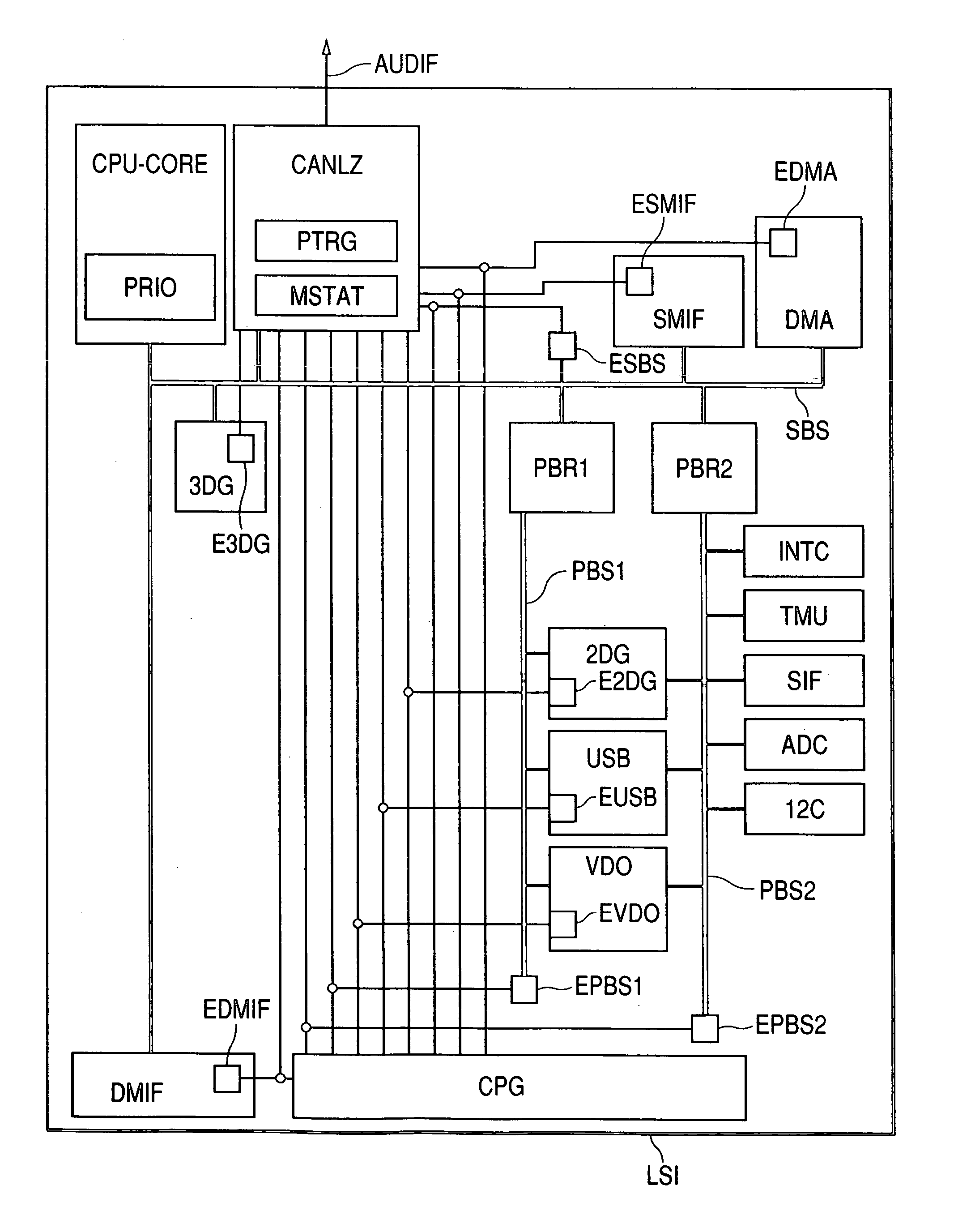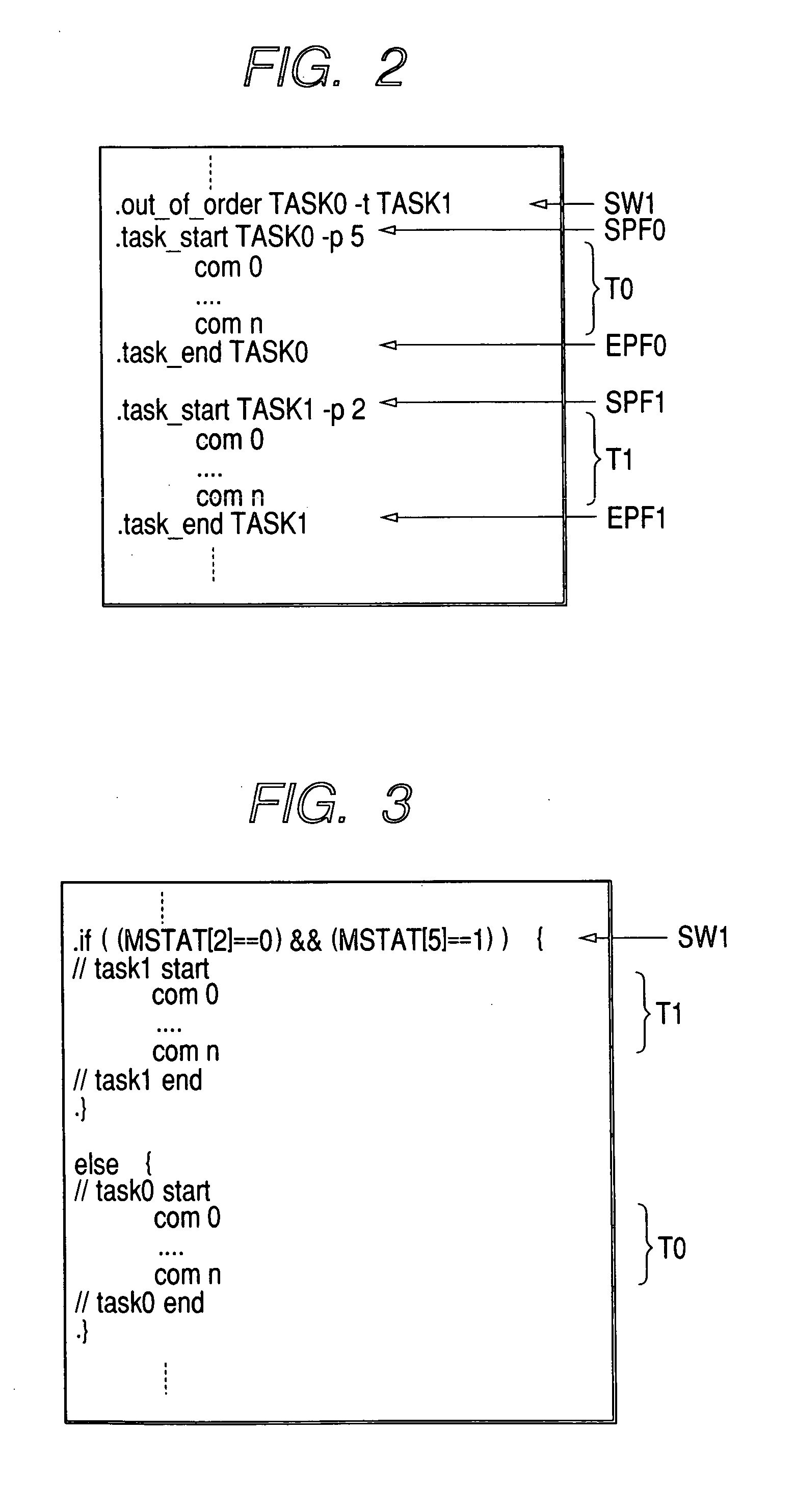Data processing device
a data processing device and data processing technology, applied in the field of large-scale integrated circuits, can solve the problems of increasing the cost, affecting the smooth display of moving pictures, and often arising performance bugs beyond the anticipation of programmers, so as to improve the performance of data processing devices
- Summary
- Abstract
- Description
- Claims
- Application Information
AI Technical Summary
Benefits of technology
Problems solved by technology
Method used
Image
Examples
first embodiment
[0033]FIG. 1 shows the configuration of a data processing device equipped with an observation block according to the invention. The data processing device according to the invention is, though not limited to, an LSI formed over a single semiconductor substrate. As shown in FIG. 1, this LSI includes a CPU core (CPU-CORE), a system bus SBS, a bus bridge PBR1 for performing protocol exchanges between this system bus SBS and a peripheral bus PBS1, a bus bridge PBR2 for performing protocol exchanges between the system bus SBS and a peripheral bus PBS2, a direct memory access controller DMA for transferring data on the system bus without passing the CPU core, a DRAM interface controller DMIF, an SRAM / ROM interface controller SMIF, a 3D graphics accelerator 3DG, a 2D graphics accelerator 2DG, a USB interface controller USB, a video interface controller VDO, a clock controller CPG, an interrupt controller INTC and other peripheral circuits.
[0034] Besides these circuits, every one of the ci...
second embodiment
[0052] This embodiment has a status referencing circuit MSTAT to enable the state of each observation object circuit obtained from the observation blocks to be referenced from the CPU core as shown in FIG. 1.
[0053]FIG. 4 shows an example of MSTAT. MSTAT is packaged as a 32-bit register, and each bit of the register show whether or not the pertinent module is usable. Information on whether or not each package is in a usable state is conveyed by way of a STAT signal connected from each of the status observation blocks ESBS, EPBS1, EPBS2, ESMIF, EDMIF, EUSB, E3DG, E2DG and EDMA in FIG. 1 to MSTAT. For instance, bits 0 and 1 for the status referencing circuit MSTAT indicate whether or not the DRAM interface controller DMIF is usable. In other words, it indicates the state of the command queue DMQ which DMIF has. If this value is 0, an entirely unoccupied state is indicated, or if it is 1 or above, it means that processing is already booked for, and the issuance of any more processing r...
third embodiment
[0058]FIG. 5 shows a mechanism for feeding back information from an observation block for system bus ESBS on the system bus SBS and a bus observation block EPBS on the peripheral bus PBS to the clock controller CPG. ESBSS and EPBSS are information conveying signals from the respective observation blocks. The clock controller CPG is equipped inside with a frequency divider DIV which divides the frequency of the reference clock, and supplies its clocks to individual circuits. In this embodiment, it supplies a clock SCK to the system bus SBS and a clock PCK to the peripheral bus PBS. The clock controller CPG knows bus statuses from the ESBSS and EPBSS signals, dynamically alters the division ratio setting to match the states, and accordingly alters the clocks to be supplied to these bus circuits. These localized frequency alterations can raise the operating frequency in only the needed part, and thereby allows optimization in both power and processing speed aspects. Moreover, as the fr...
PUM
 Login to View More
Login to View More Abstract
Description
Claims
Application Information
 Login to View More
Login to View More - R&D
- Intellectual Property
- Life Sciences
- Materials
- Tech Scout
- Unparalleled Data Quality
- Higher Quality Content
- 60% Fewer Hallucinations
Browse by: Latest US Patents, China's latest patents, Technical Efficacy Thesaurus, Application Domain, Technology Topic, Popular Technical Reports.
© 2025 PatSnap. All rights reserved.Legal|Privacy policy|Modern Slavery Act Transparency Statement|Sitemap|About US| Contact US: help@patsnap.com



